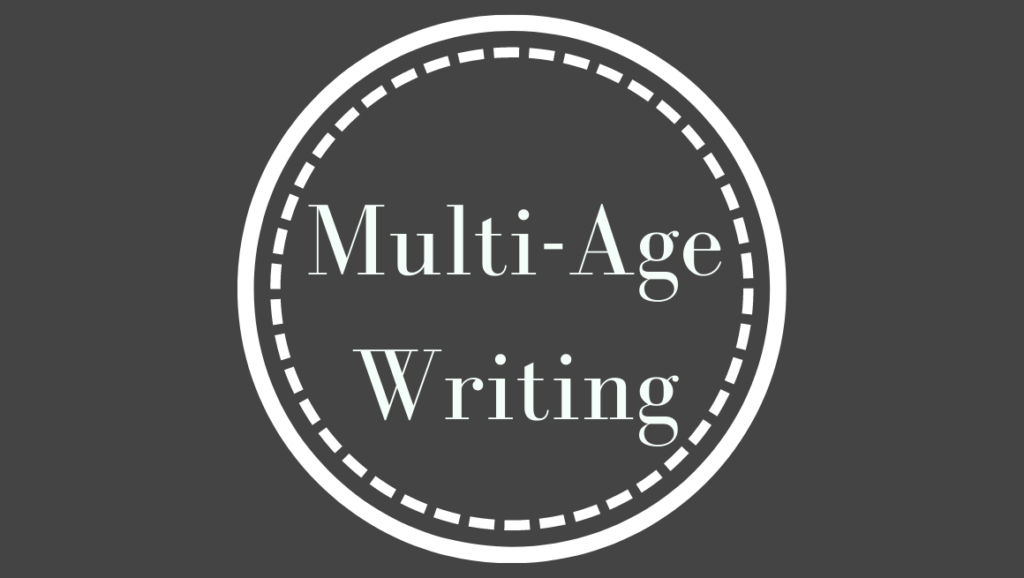Multi-Age Writing
In homeschool or during the summer for public and private school kids, we’re faced with multiple ages learning and writing around one table.
How do we make it fit without making a new lesson for every kid?
One of the most successful writing times in our home is when use one text and stretch it to fit the ages and learning levels of both boys (ages 6 -kindergarten and 8-third grade).
Showcase the Text
The first step is to write out the text on something big.
We like to use our chalkboard.
I chose the lead of a book for this particular lesson.
Just the first few sentences of a book my son loved called A Cricket in Times Square worked well to analyze some basic reading points and start a new story in our own Writer’s Notebooks.
Read the Text Multiple Times
The oldest read the text aloud, so I could get a sample of where he was at in his fluency.
I then read it aloud again as he followed along, so he could hear how it should sound.
We can talk about how his voice should sound both in his mind and aloud as he reads when we do this.
For my emerging reader, I put my finger under each word as I read, so he could be immersed in words new and already known.
Stopping to let him read the words he’s already memorized to help me out makes him feel like a big helper, too.
Find What’s Right, Not What’s Wrong!
In Everyday Editing by Jeff Anderson, he teaches that the old idea of fixing up broken sentences like we experienced in school is the backward way of learning.
I found this to be a much better way to teach my 8th graders years ago, and I still find it to be true with my boys in homeschool.
For today, A Cricket in Times Square was the text, making George Selden what we call our “mentor.”
Someone who is published.
A great writer we can learn from.
Just like how every major leaguer once watched his favorite MLB star swing a bat over and again, we watch our authors.
What do they do that’s amazing?
How can we create that in our own writing?
I asked each boy specific questions.
For my oldest I asked about possessive nouns. Why is this apostrophe different than a contraction? Why did Seldon need it here?
What do words like, “Times Square, abandoned drain pipe, and subway” give the reader in the beginning of the book?
For my youngest, I asked questions like, “What did Seldon do at the start of every sentence?”
What did he do when he was finishing his sentence?
Why didn’t he use an exclamation point or question mark instead?”
Link it to a Writing Piece
For my youngest, I grabbed one of his blank books.
If you don’t have these stock-piled somewhere in your learning space, grab them fast! Your kids will LOVE becoming authors in their own bound books to put on the shelf!
His mission was to draw the cat and mouse he visualized in his mind’s eye as we read.
He told me what they were doing, and we worked together to write simple sentences to help tell his own version of the story.
It was fun to see how his mind saw the words we just read.
While my six-year-old started drawing, my eight-year-old and I looked at the key pieces of the text we were examining.
“What are the words ‘mouse and Mario?'”
Characters.
“You get to create two characters!”
My little non-writer panicked.
“Let’s play a game to decide. I’ll name a kind of character, and you name a kind of character on the count of three. No matter what kind they are, you’ll make them both a part of your story. Even if they don’t seem to go together. We’ll make it fun! Got it? One…two…three!”
He said inventor. I said troll.
“What words did we say were giving us setting?”
He answered the words he saw on the board from the text. I circled them.
“Okay, let’s choose your own setting. You pick the specific kind of place, and I’ll choose the big location. One…two…three!”
He chose an underground laboratory. I chose Alaska. He changed it to an underground Alaskan ice lab where an inventor creates a troll that helps him make his creations.
At this point, he was excited and ready to go!
Keep It Small
One way to keep your writers loving the art of writing, is keeping your lessons and the amount they write small.
Realizing it didn’t all have to happen today (and shouldn’t) was one of the best things that happened to me as a teacher.
Just write this starting point.
Just get going.
Tomorrow you can look at how an author crafts his characters. Then later in the week, his plot, another day his problems, next week his solutions, and even later his conclusions.
We can slowly investigate writing with our author’s eye looking for the genius behind our favorite authors.
But what’s best…we can be successful because they showed us how.
Celebrate!
Writing should be fun and exciting!
In this house, I have one who likes to write and one who really really does not.
So, whenever we finish even one small part of writing, we read it aloud to everyone.
We celebrate.
Laugh.
Do immediate quick fixes (editing) because that’s what great authors do.
Read, we write, and we do it all together.
One former English teacher, one kid who can’t read yet, and one kid who’s an avid reader but avoids writing like the plague.
We enjoy this process.
In its beauty and craft, it can be shaped, molded, and shared.
No matter what age. What interest. What ability.
Writing is for everyone.

